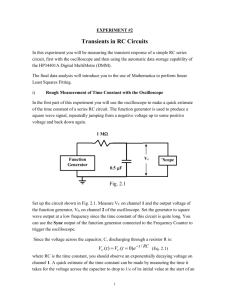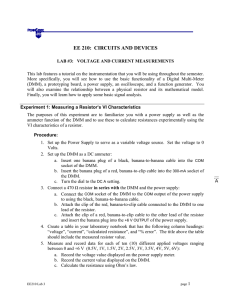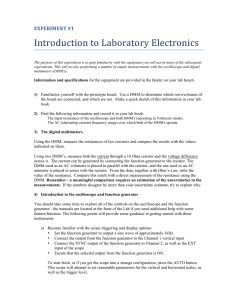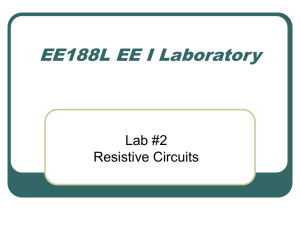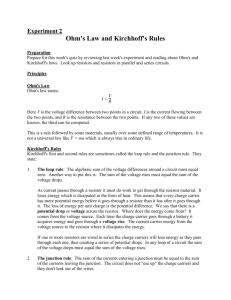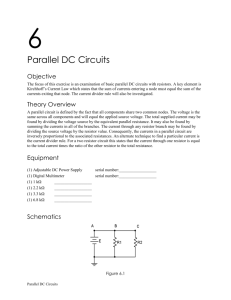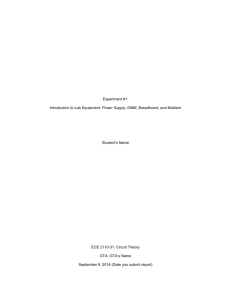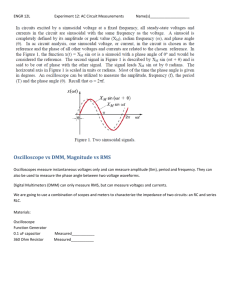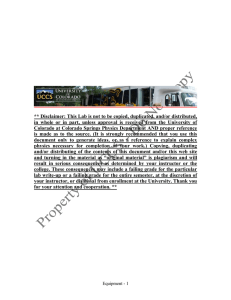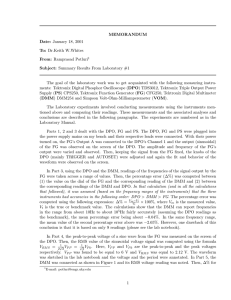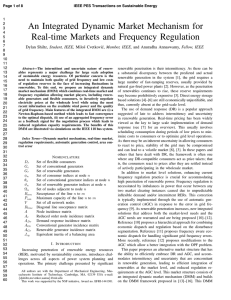Introduction to lab Curie 2011
advertisement
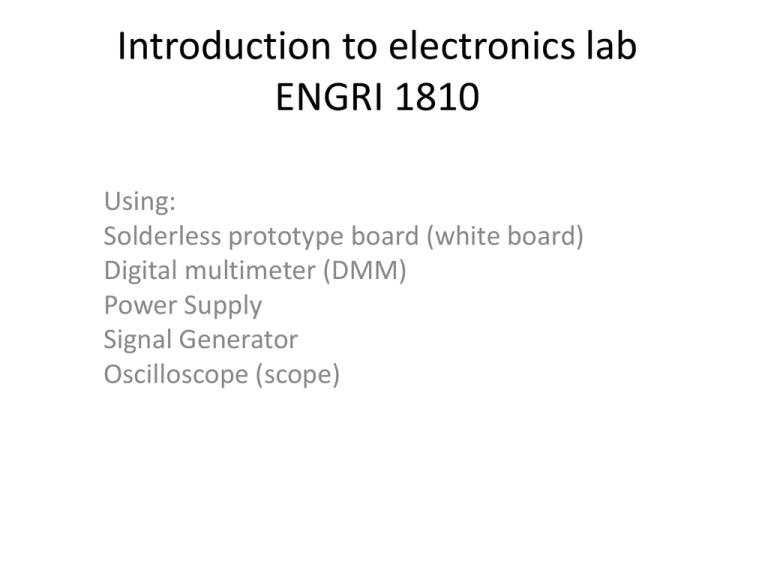
Introduction to electronics lab ENGRI 1810 Using: Solderless prototype board (white board) Digital multimeter (DMM) Power Supply Signal Generator Oscilloscope (scope) White board You can push wires into holes which can then connect to other wires. Connections are grouped as shown below. You will be building circuits on these boards. Example circuit (just to see what it looks like) DMM • The DMM measures -- voltage -- resistance -- capacitance -- current DMM examples 1 • Set the DMM to read 20 volts full scale DC. Hook up the DMM leads to the power supply and measure the voltage. Turn the +V adjust knob to vary the voltage. (more on power supply slide) • Note that attempting to read current or resistance while connected to power will break the DMM. DMM examples 2 • Remove the leads from the power supply and set the DMM to read resistance, 2K full scale. • Plug a 1K resistor into the white board (right hand side of image and zoom) and touch the DMM probes to the resistor leads. • In this case, the 1K nominal resistor is actually 0.984K. Power Supply • Produces three different constant voltages to power your circuits. -- Fixed +5 volts (red terminal) -- Variable +1 to 20 volts using knob +V (yellow) --Variable -1to -20 volts using knob –V (blue) • Always test/set the voltage with a DMM before attaching to your circuit. Hook up the DMM to each output and vary the knobs. Signal Generator • Frequency is set by the controls surrounded by magenta. Top row buttons set frequency range, two knobs for fine control, LED readout. • Wave shape is set by the controls surrounded by green. Choices are sine, triangle, square wave. • Signal amplitude is set by knob surrounded by yellow, which also indicates the output connector. • All other controls should be set to off for now. Full manual: http://people.ece.cornell.edu/land/courses/ece4760/equipment/BK4040a.pdf Signal generator layout We will play with the signal generator after introducing the oscilloscope. Oscilloscope (scope) 1 • This instrument reads out voltage waveforms on the screen. There are two input channels. The voltage scale and offset of each channel can be set by using the knobs around the “vertical controls” while timescale and offset can be set by the “horizontal controls”. Oscilloscope (scope) 2 • The scope has two input probes which can measure two voltages in your circuits. • The scope can be used for voltages from 20 mV to 20 volts, which implies that you need to be able to set the scale of the voltage axis. • The scope can be used for signals which have a frequency of 10 million Hz or 0.01 Hz, which implies that you need to be able to set the scale of the time axis. • Many signals change so fast that your slow human eyes cannot follow them. The trigger section of the scope attempts to synchronize fast events so they are easier to see. Oscilloscope (scope) 3 • The scope has an Autoset button which often will set up the scope automatically for you (but sometimes does very silly things). • The Run/Stop button will freeze the display to you can measure it. • The measure button sets up automatic measurement of voltage changes, durations, frequencies, etc. • The cursor button sets up manual measurement of anything you want. The big knob on the left moves the cursors on the screen. Scope and signal generator 1 • Connect the output of the signal generator (red clip lead) to the channel 1 probe of the scope as shown. • Connect the channel 2 probe to the probe comp self-test point. This puts a 5 volt, 1 KHz square wave on channel 2. • Set the signal generator to about 1KHz sine wave, and press Autoset on the scope. You should see something like the display below when you Press Run/Stop. When the display is running, you will need to Modify the triggering to see the square wave clearly. Press the Trigger menu button and choose channel 2 from the screen menu. Scope and signal generator 2 • Press the measure button and look at the right-edge screen display. You can change what is being measured using the onscreen menu. • Press the cursor button. Set the cursors to Time and use the big knob to move the cursors to measure one sine cycle. Scope, signal gen and resistor circuit • Build an resistor circuit as shown in the schematic and picture • Connect the input resistor to the signal gen and scope channel 1. • Connect the output resistor to scope channel 2. • Vary the frequency of the signal gen and watch what happens to the chan2 signal. • Switch to a square wave. What do you see? • With a 365Hz sine wave you should see: Scope, signal gen and RC circuit (low pass filter) • Build an RC circuit as shown in the schematic and picture. Be sure to ground the negative side of the capacitor. • Connect the resistor to the signal gen and scope channel 1. • Connect the positive side of the capacitor to scope channel 2. • Vary the frequency of the signal gen and watch what happens to the chan2 signal. • Change to a square wave and see what happens. • Note amplitude change, phase shift and rounding. Measure the time constant. Scope, signal gen and RC circuit (high pass filter) • Build an RC circuit as shown in the schematic and picture. • Connect the capacitor to the signal gen and scope channel 1. • Connect one side of the resistor to scope channel 2. • Vary the frequency of the signal gen and watch what happens to the chan2 signal. • Note amplitude change, phase shift and spiking.
